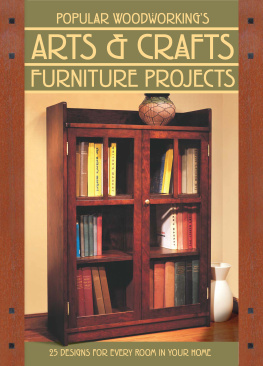Freudenheim - Building with Nature: Inspiration for the Arts & Crafts Home: Inspiration for the Arts & Crafts Home
Here you can read online Freudenheim - Building with Nature: Inspiration for the Arts & Crafts Home: Inspiration for the Arts & Crafts Home full text of the book (entire story) in english for free. Download pdf and epub, get meaning, cover and reviews about this ebook. year: 2005, publisher: Gibbs Smith Publ, genre: Detective and thriller. Description of the work, (preface) as well as reviews are available. Best literature library LitArk.com created for fans of good reading and offers a wide selection of genres:
Romance novel
Science fiction
Adventure
Detective
Science
History
Home and family
Prose
Art
Politics
Computer
Non-fiction
Religion
Business
Children
Humor
Choose a favorite category and find really read worthwhile books. Enjoy immersion in the world of imagination, feel the emotions of the characters or learn something new for yourself, make an fascinating discovery.
- Book:Building with Nature: Inspiration for the Arts & Crafts Home: Inspiration for the Arts & Crafts Home
- Author:
- Publisher:Gibbs Smith Publ
- Genre:
- Year:2005
- Rating:4 / 5
- Favourites:Add to favourites
- Your mark:
Building with Nature: Inspiration for the Arts & Crafts Home: Inspiration for the Arts & Crafts Home: summary, description and annotation
We offer to read an annotation, description, summary or preface (depends on what the author of the book "Building with Nature: Inspiration for the Arts & Crafts Home: Inspiration for the Arts & Crafts Home" wrote himself). If you haven't found the necessary information about the book — write in the comments, we will try to find it.
Freudenheim demonstrates how the simple life manifested in the rustic architecture found in Yosemite, English cottages, Japanese barns, and Swiss chalets, became the basis for the design of the American Arts and Crafts home advocated by these pioneering thinkers. Their devotion to simplicity for both the interior and exterior design of these houses also helps to explain why they embraced plain, sturdy Mission Style furniture. Freudenheim points out how numerous individuals, both American and British, helped spread these ideas across America.
Building with Nature charts the influence of Reverend Joseph Worcester of the San Francisco Swedenborgian Church for whom the first Mission Style chair was designed in 1894. The book also shows how Worcesters friends, A. Page Brown, Willis Polk, Bruce Porter, Ernest Coxhead and Bernard Maybeck established the first American Arts & Crafts Society or Guild in 1894. Freudenheim also explores the possible role of A. C. Schweinfurth in the design of the Swedenborgian Church and quotes extensively from Charles Keeler who documented the growth of the Arts & Crafts Movement in the Bay Region.
The book shows how Gustav Stickley found Californias architecture so inspiring during his four-month exploration of the state in 1904 that he thereafter promoted numerous versions of the California Arts and Crafts home in Craftsman magazine. In the August 1912 issue Stickley argued: The value of Western architecture, locally and to the nation at large, and its widening influence upon homebuilding all over the country, are facts not to be estimated lightly....
Describing the cross-fertilization of American and European ideas, Freudenheim also quotes visitors such as C.R. Ashbee, the English Arts and Crafts architect and founder of the School and Guild of Handicraft in London, who knew the American Arts and Crafts scene well, having traveled in the East and Midwest multiple times from 1896 on. In early 1909, Ashbee visited both Northern and Southern California and enthused: California speaks.... Here things are really alive--and the Arts and Crafts that all the others were screaming about are here actually being produced...on the Pacific Coast.
Freudenheim: author's other books
Who wrote Building with Nature: Inspiration for the Arts & Crafts Home: Inspiration for the Arts & Crafts Home? Find out the surname, the name of the author of the book and a list of all author's works by series.



















